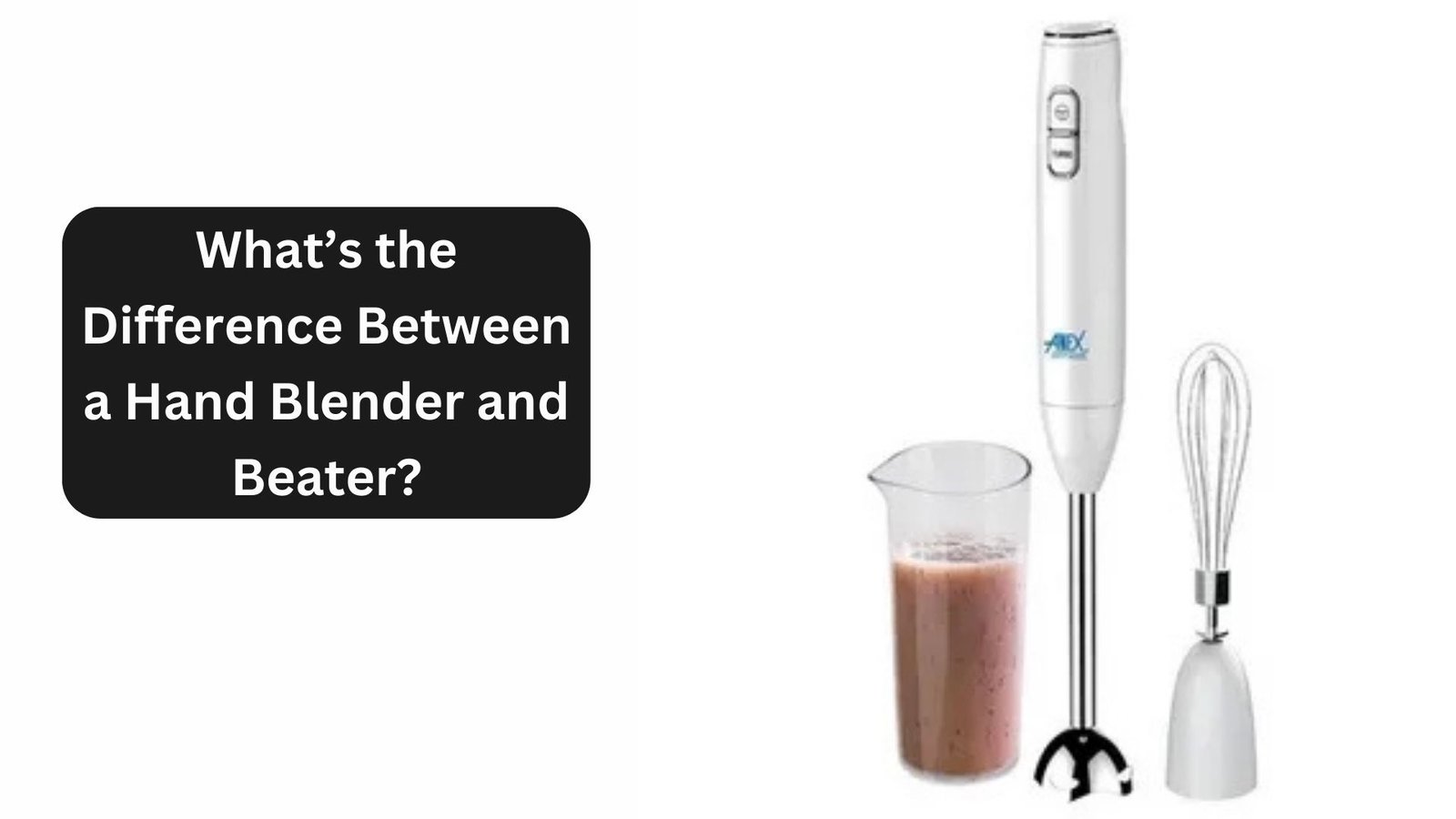In modern kitchens, appliances are designed to simplify and enhance the cooking process, making it quicker and more efficient. Among these essential tools, hand blenders and beaters are frequently used but often confused with each other. Although both devices are handheld and assist in various culinary tasks, they serve different purposes and come with unique features. This article delves into the key differences between a hand blender and a beater, helping you decide which tool suits your cooking needs best.
Understanding the Basics of a Hand Blender
What is a Hand Blender?
A hand blender, also known as an immersion or stick blender, is a handheld device with a small, powerful motor designed to blend, purée, and mix ingredients directly in a pot, bowl, or container. Hand blenders are commonly used to make soups, smoothies, sauces, and other recipes that require liquid blending. Their elongated shape allows them to reach deep into pots or bowls, eliminating the need to transfer contents to a separate blender jar.
How Does a Hand Blender Work?
The hand blender operates through a rotating blade at its base, which moves at high speeds to blend ingredients. Many models come with detachable attachments, making them versatile for various tasks, such as whisking and chopping. When the blender is immersed in the ingredients, it creates a whirlpool effect, pulling ingredients toward the blade to ensure a smooth and even texture.
Key Uses of a Hand Blender
Hand blenders are ideal for tasks that require blending or puréeing. Here are some popular uses:
- Blending Soups and Sauces: With a hand blender, you can blend soups directly in the pot, avoiding the hassle of transferring hot liquids to a separate blender.
- Making Smoothies and Milkshakes: Hand blenders are powerful enough to crush soft fruits and blend liquids for a quick smoothie or milkshake.
- Pureeing Baby Food: A hand blender is perfect for creating smooth, nutritious baby food right in the pot.
- Whisking and Chopping: Some hand blenders come with attachments for whisking eggs or chopping vegetables, expanding their functionality.
NOTE : Differences in purpose for hand blender and beater were explored. Hand blenders handled soups and sauces, while beaters excelled at batters and whipped cream. For top brands, visit Bijli ki Dukan.
Understanding the Basics of a Beater
What is a Beater?
A beater, commonly known as a hand mixer or electric whisk, is a handheld device specifically designed to beat, whisk, and mix ingredients. Unlike hand blenders, beaters are generally used for baking purposes, such as whipping cream, beating eggs, and mixing batter. They usually come with two beaters or whisk attachments that rotate at high speeds, aerating ingredients to create a light and fluffy texture.
How Does a Beater Work?
A beater works by rotating the beaters or whisk attachments to mix and aerate ingredients. Most beaters come with adjustable speed settings, allowing users to control the intensity based on the desired consistency. The beaters are designed to incorporate air into the mixture, making them ideal for recipes that require light and airy textures, such as cakes and mousses.
Key Uses of a Beater
Hand beaters are primarily used for tasks that involve mixing, whipping, or beating ingredients. Some common uses include:
- Whipping Cream and Eggs: A beater is perfect for creating whipped cream or beating egg whites to soft or stiff peaks, essential for baking recipes.
- Mixing Batter for Cakes and Cookies: Beaters excel in mixing batters for cakes, cookies, and muffins, ensuring a smooth, consistent texture.
- Kneading Dough: Some hand beaters come with dough hook attachments, which can be used for kneading dough for bread and pizza.
- Preparing Light, Airy Mixtures: Recipes that require a fluffy texture, such as soufflés and meringues, benefit from the aeration provided by a beater.
Comparing Design and Structure
Design of a Hand Blender
Hand blenders are typically long and slender, with a motor at the top and a blade attachment at the base. Their design allows for easy immersion into pots, bowls, and jars, making them convenient for blending directly in containers. Hand blenders often come with detachable parts, allowing users to switch between attachments or easily clean the device. The blade is usually housed within a protective cage to prevent splattering and ensure safe operation.
Design of a Beater
Hand beaters have a different design, with a handle that holds the motor and a pair of rotating beaters or whisks at the base. Their structure is bulkier than a hand blender but allows for better control during mixing and beating tasks. Beaters are designed for horizontal mixing, making them ideal for tasks that require aeration and whipping. Most beaters come with multiple speed settings, allowing users to adjust the speed to suit the consistency of the mixture.
Performance and Functionality
Power and Speed Variations
Both hand blenders and beaters vary in terms of power and speed, but each is tailored to specific tasks.
- Hand Blenders: These devices generally have higher power levels, ranging from 200 to 800 watts, to handle blending and puréeing tasks efficiently. Many hand blenders come with adjustable speed settings, allowing users to blend ingredients to the desired consistency.
- Beaters: Hand beaters typically have lower power, between 100 to 300 watts, as they are used for lighter mixing tasks. However, they offer a range of speed settings, allowing for controlled whipping and beating. Some high-end beaters come with a “turbo” function for extra power when needed.
Versatility in Usage
Hand blenders are more versatile in terms of functionality, as they can be used with multiple attachments for blending, chopping, whisking, and even crushing. Beaters, on the other hand, are specialized for tasks that involve mixing, whipping, and beating. While some beaters come with dough hooks or whisk attachments, they lack the blending capabilities of a hand blender.
Ease of Cleaning and Maintenance
Cleaning and maintenance are important factors when choosing between a hand blender and a beater.
- Hand Blenders: Most hand blenders come with detachable parts, making them easy to clean. The blade attachment can be rinsed or washed separately, ensuring thorough cleaning. However, the immersion design may require additional care to prevent food particles from sticking.
- Beaters: Beaters are generally easier to clean, as the beaters or whisks can be removed and washed separately. The handle and motor portion of the device can be wiped clean with a damp cloth. However, if the beaters are used with sticky or thick mixtures, they may require more thorough cleaning.
Key Differences Between Hand Blenders and Beaters
To summarize, here are the primary differences between hand blenders and beaters:
- Functionality: Hand blenders are designed for blending, puréeing, and chopping, whereas beaters are primarily for mixing, whipping, and aerating ingredients.
- Design: Hand blenders have a slim, elongated design for easy immersion, while beaters are bulkier with twin beaters or whisks for effective mixing.
- Power: Hand blenders are generally more powerful than beaters, allowing them to handle tougher ingredients.
- Versatility: Hand blenders are more versatile, with multiple attachments for different tasks. Beaters are specialized for mixing tasks.
- Ease of Cleaning: Both are easy to clean, but hand blenders may require more attention due to their immersion design.
Choosing Between a Hand Blender and Beater
When to Choose a Hand Blender
If you frequently make soups, smoothies, sauces, or purées, a hand blender is the ideal choice. It is perfect for recipes that require smooth blending or liquid consistency. A hand blender is also a good option for those who prioritize versatility, as it can come with attachments for various tasks. Additionally, hand blenders are great for those with limited kitchen space, as they are compact and easy to store.
When to Choose a Beater
For baking enthusiasts, a beater is the better choice, as it is tailored for mixing, whipping, and beating. If you often make cakes, cookies, whipped cream, or meringues, a beater will provide the consistency and texture needed for these recipes. A beater is also ideal for those who need a tool specifically for mixing and aerating tasks, making it a valuable addition to any baking setup.
Conclusion
In summary, while both hand blenders and beaters are valuable kitchen tools, they serve different purposes. A hand blender is ideal for blending, puréeing, and creating smooth textures, making it suitable for tasks like soup and smoothie preparation. On the other hand, a beater is designed for mixing, whipping, and aerating, making it the perfect companion for baking needs.
Understanding the distinctions between a hand blender and a beater allows you to select the right tool based on your cooking and baking habits. Each appliance has unique strengths, and choosing the right one will help enhance your efficiency and creativity in the kitchen. Whether you prioritize versatility, texture, or ease of use, both hand blenders and beaters are essential tools that can elevate your culinary experience.
For More Insightful Articles Related To This Topic, Feel Free To Visit : empireadda


